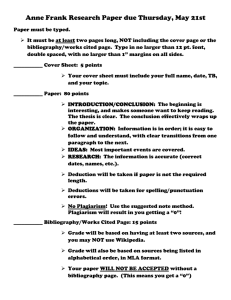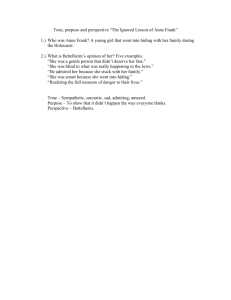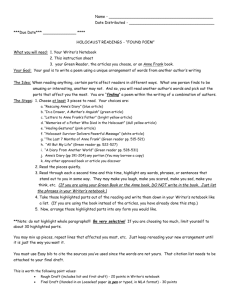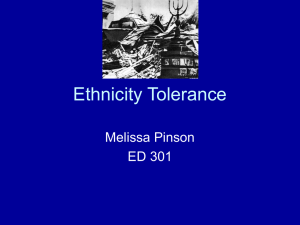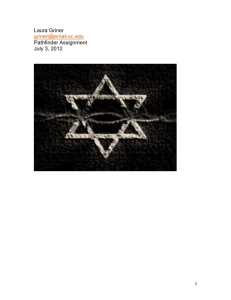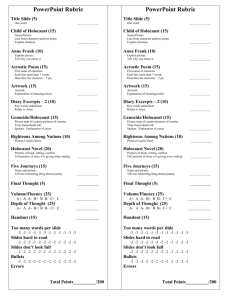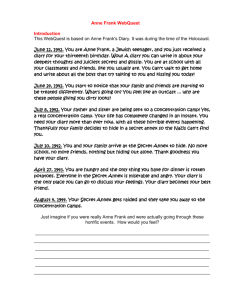Holocaust Sub-Genre by Sarah Sullivan
advertisement
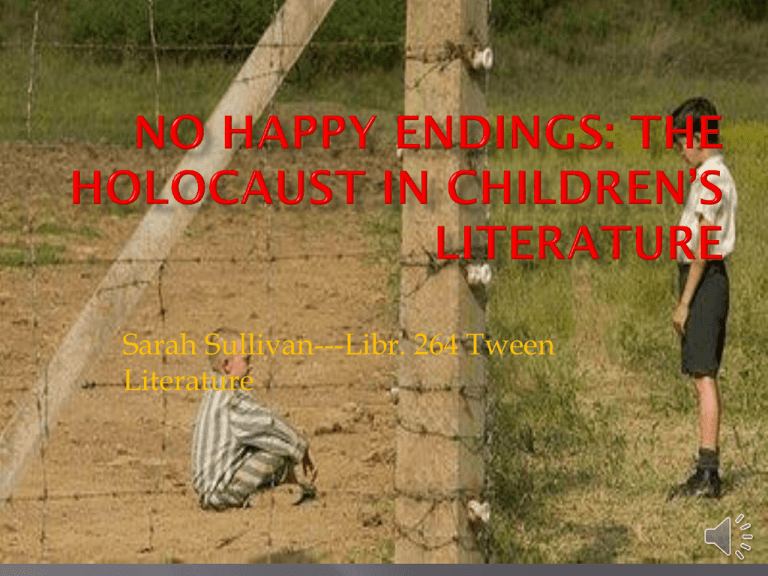
Sarah Sullivan---Libr. 264 Tween Literature Traditional Children’s Literature Wonder Woman takes on the Nazis. Traditional literature for children/tweens features a young protagonist who, through her struggles, emerges stronger, wiser, and hopeful about the future. Struggles must lead to catharsis. True of both biography and fiction. Survival Statistics (Pictured): 54 Children found alive at the liberation of Bergen-Belsen. Overall Europe: Of 1.5 million Jewish children under 16 in 1939, 175,000 survived the war. Poland: Of 1 million Jewish children under 14 in 1939, 5000 were alive in 1945. Early Biographical Literature Amusement and Discovery (Pictured): Millie Perkins as Anne Frank in 1959 movie. “…Anne Frank’s diary simply bubbles with amusement, love, and discovery…it is a warm and stirring confession to be read over and over again.” --- New York Times 1952 , Book Review Early versions of Anne Frank’s diary deliberately removed overt references to her Jewish identity. Thanks To My Mother (2000) Schoschana Rabinovici Short, picture book. Pencil drawings combined with simple narration. Overly positive representations trivialize horror. Overly negative representations may not be appropriate for children. Necessary to find a balance The Devil’s Arithmetic (1990) Uses elements of science fiction to tell protagonist’s story. Teenage girl travels back in time, finds herself transformed into a Jewish girl on her way to Auschwitz. Able to combine hopeful ending with more realistic portrait of Holocaust. Han Nolan (1994) Comatose adolescent neo-Nazi finds herself trapped in Holocaust survivor’s memory. Darker than “Devil’s Arithmetic.” Subdued hope at end: no longer neo-Nazi, but still confused. Jordan, S. D., (2004) Educating Without Overwhelming: Authorial Strategies in Children's Holocaust Literature. Children's Literature in Education, 35 (3), 199–218. Retrieved at: http://web.ebscohost.com.libaccess.sjlibrary.org/ehost/detail?sid=665ac808-71ce-4aa9-bd6298e05d27f3bc%40sessionmgr10&vid=1&hid=24&bdata=JnNpdGU9ZWhvc3QtbGl2ZQ%3d%3d#db=aph&AN=14426263 Kertzer, A. (2000). Like a Fable, Not a Pretty Picture: Holocaust Representation in Robert Benigni and Anita Lobel. Michigan Quarterly Review, 39 (2). Retrieved From: http://quod.lib.umich.edu/cgi/t/text/textidx?cc=mqr;c=mqr;c=mqrarchive;idno=act2080.0039.213;rgn=main;view=text;xc=1;g=mqrg Martin, M. J., (2004) Experience and Expectations: The Dialogic Narrative of Adolescent Holocaust Literature, Children’s Literature Association Quarterly, 29 (4). Retrieved at: http://muse.jhu.edu.libaccess.sjlibrary.org/journals/childrens_literature_association_quarterly/v029/29.4.martin.html Tal, E., (2004). How much Should We Tell the Children? Representing Death and Suffering in Children’s Holocaust Literature. Retrieved at: http://www1.yadvashem.org/yv/en/education/conference/2004/43.pdf Frank, Anne. Anne Frank: The Diary of a Young Girl. New York: Doubleday, 1952 Nolan, Han. If I Should Die Before I Wake. New York: Harcourt, 1994. Rabinovici, Schoschana. Thanks To My Mother. New York: Dial Books, 1998. Vander Zee, Ruth. Erika’s Story. South Bend: Creative Edition, 2003. Yolen, Jane. The Devil’s Arithmetic. 1988. New York: Puffin, 1990.

